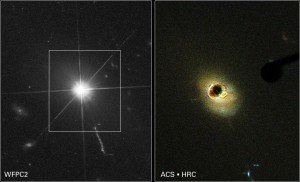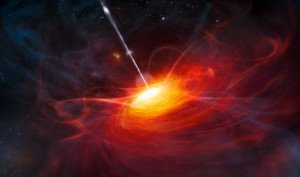
“Quasar viewed from Hubble” by NASA and J. Bahcall (IAS)Credit for ACS image: NASA, A. Martel (JHU), H. Ford (JHU), M. Clampin (STScI), G. Hartig (STScI), G. Illingworth (UCO/Lick Observatory), the ACS Science Team and ESA – Public Domain.
“Where is the centre of the Universe?” Ask any Astrophysicist, even a secular star like Neil Degrase Tyson or the Vatican’s own expert Brother Guy Consolmagno, SJ, that simple question and their first answer will be, “there isn’t one–at least–not that we can tell.” You’ve just stumbled on one of the most misunderstood and mind-bending features of the “Big Bang” theory of the origins of the Universe. Most people think of the Big Bang as an explosion in space–all of the matter of the universe expanding outward at near light speed from a single point. If that were true that the whole universe could be mapped like a spherical cloud, and we could easily point to the middle of that cloud and say, “There! That’s where it all began!” Whether or not there is still anything interesting at that point in space-time would be a different question, but the nostalgia of the importance of those coordinates would be reassuring and definitive. Like when your parents drive you by the hospital where you were born or the house where they grew up, there would be some reassurance in the astronomer’s finger pointing into the night sky and saying, “right about there… that’s where we came from…”
Yet Dr. Neil would be the first to tell you that cosmology turns out to be a little more complicated than that. The truth is that the Big Bang was not not an explosion in space, it was an explosion of space. The favourite analogy used by many patient professors imagines a balloon with dots inked on the surface. As the balloon expands, the space between the dots lengthens. The expanding diameter of the balloon might be thought of as representing time. As time stretches out so does the distance between the dots. But if you, on the 2-dimensional surface of the balloon, where to attempt to locate the center of all those dots, you couldn’t do it. The numbers of dots you could observe, on the surface, would be the same in every direction no matter where you stationed yourself on that surface.
It’s the same in astrophysics. If there was a “centre” of the Universe you would expect to see more “stars, galaxies, and the planets in their courses” in some parts of the sky than others. That is, as we looked toward the “centre” it would appear more dense with celestial objects and radiation than if we looked in the opposite direction. (Unless, of course, we were lucky enough to be at the centre of the Universe after all, but Copernicus had something to say about that.) But it truth you can point a telescope in any direction in the night sky and if you look into the deepest darkest space (past the Milky Way) you will see about the same amount of stuff. This is true whether you are talking about background radiation leftover from the big bang, observable galaxies, or the even the extremely ancient and distant quasars–there is no centre.
In fact… just to make things weirder… if you were to keep going in any one direction long enough would eventually come back to the same spot you started (because space is curved, after all).
I bring this scientific non-nugget to your attention because I think the structure of the universe has something interesting to say about how we get to the centre of things. I contend that our efforts to point squarely in one direction and say, “there, that’s the centre/truth/origin” will never be anything more than a gesture at a guess of an approximation of an estimate. Yet there is another way.
Consider this lovely gem by Emily Dickinson you probably first heard in High School:
Tell all the truth but tell it slant —
Success in Circuit lies
Too bright for our infirm Delight
The Truth’s superb surprise
As Lightning to the Children eased
With explanation kind
The Truth must dazzle gradually
Or every man be blind — (source)
It is the nature of Christian revelation to speak truth slant-wise. We play poet and trickster when the world wants engineer or accountant. But if we accept the off-kilter character of Christian truth-telling we join stellar company.
Consider, first of all, the phenomenon of the accretion disc. When a cloud of gasses in space starts to contract due to gravity the cloud organizes itself into a spinning disc on a plane. This is why the planets in our solar system are located (more or less) on the same orbital plane. It’s true on a bigger scale, as well, like how galaxies seem to universally form into disc-shapes. It’s like when you pull the plug in the tub and the water creates a curved spiral. When things are coming together, they like to swirl. The universe does not like straight lines.
The most spectacular celestial version of this is the mighty quasar. The existence of these deep-space objects was controversial even into the 1980’s, but we’ve come a long way since then. According to Wikipedia more than 200,000 Quasars have been located. Even though these are the brightest objects in the Universe they are so far away that only one can be directly observed with an amateur telescope. Quasars form when the centre of a galaxy contains a super-massive black hole. As the matter in the accretion disc spirals into the hole friction and special gravitational forces cause it to heat up and release energy across the entire spectrum (including X-rays, visible light, etc.). Imagine a process even more powerful than nuclear fusion–one of the many mysteries surrounding these places. If a quasar was parked 33 light years away from us it would be as bright as the sun in the sky.
Back on earth… observe the way that Jesus circles and circles around the truth of his mission. In parables such as the one appointed for this Sunday he makes oblique references to otherwise frightening end-time prophesies. And even though we get our Lord’s own interpretation of the “Wheat and the tares” parable, it leaves us uneasy about what he’s not saying. It’s like that scene in “Lost in Translation” when a Japanese Director speaks for several passionate minutes in his own language only to have in translated as “He wants you to turn, look in camera. O.K.?” by the translator. Clearly, Jesus is not telling his disciples the whole truth about what this parable means.
And how could he? Time and again his more direct attempts to point to the centre of things is met with confusion, rejection, and hostility. So he swirls around and around the black hole of the blackest Friday: spiraling downward toward his inevitable execution. As with the quasar, things start to heat up as the circles become smaller, the velocities faster, and characters more compressed.

“Artist’s rendering ULAS J1120+0641” by ESO/M. Kornmesser – http://www.eso.org/public/images/eso1122a/. Licensed under Creative Commons Attribution 3.0 via Wikimedia Commons
Quasars are more than spirals of light plummeting into nothingness. There is a weird “jet” of light and energy that shoots out from the centre upward and downward through the poles. Scientists have no idea why they exist, but these jets of light and energy manage to escape upward and outward from the very edge of the black hole’s event horizon.
I think there is a centre to the universe. I look at the cross and I see an axis around which the whole world spins. But even as I attempt to point at that cross–to proclaim that brightest light and darkest death and most magnificent resurrection–I know that I am getting it a little bit wrong. Try as I might, I just can’t say it true, at least not straight and true.
So we tell it slant. We speak of other crucifixions we have seen or heard; other resurrections we have witnessed. We use poems and pictures and music and overly elaborate astronomical metaphors to speak the unspeakable. Circling around and around the centre of our Universe, the Holy Cross of Christ, we tell the truth but tell it slant until we fall into that great mystery ourselves.

By Olivier Morneau July 18, 2014 - 6:05 pm
Nicely put. Very inspirational. Somewhat inaccurate from a scientific point of view I feel inclined to mention (An important distinction should be made between observable universe and whole universe since we’re talking about paradigms). But beautiful text nonetheless.